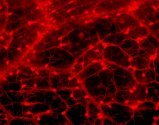
COBRE
Department of Ophthalmology
University of Oklahoma Health Sciences Center
HOME | PI | PJIs | CORES | MENTORS | IAC | EAC | SPOTLIGHT | SEMINARS | CALENDAR | AFFILIATES
John Ash, Ph.D.
Wei Cao, Ph.D.
Michael Ihnat, Ph.D.
Yun Le, Ph.D.
Raju Rajala, Ph.D.
PROMISING JUNIOR INVESTIGATOR
RAJU V.S. RAJALA, PH.D.
COBRE Research Project
RAJU V.S. RAJALA, PH.D.
COBRE Research Project
Insulin Receptor Signaling in the Retina
(Mentor, Robert E. Anderson, MD, PhD)
Insulin, a peptide hormone binds its cognate cell surface receptors to activate a coordinated biochemical-signaling network and induce intracellular events. The retina is an integral part of the central nervous system and is known to contain insulin receptors, although their function is not known. Recently, we have reported that the p85 regulatory subunit of phosphatidylinositol 3-kinase (PI3K) interacts directly with the insulin receptor-beta subunit (IRb) in retinal rod outer segments (ROS), which leads to activation of the PI3K enzyme. This interaction can be achieved either by light in vivo or through tyrosine phosphorylation of insulin receptor in vitro. This work linking PI3K activation through tyrosine phosphorylation of the insulin receptor in ROS now provides physiological relevance for the presence of these receptors in the retina. The mechanism of light activation of the insulin receptor and the functional consequences are unknown and therefore need to be investigated. In this proposal, four specific aims are outlined that will provide fundamental information on insulin receptors in the retina. 1) To test the hypothesis that photopigments and the visual transduction cascade mediate the light-stimulated tyrosine phosphorylation of the IRb. 2) To elucidate the mechanism of light-stimulated tyrosine phosphorylation of the IRb. 3) To determine the role of insulin binding protein Grb10 in the regulation of the IRb. 4) To employ transgenic frog approach to study the movement of proteins in retina. These studies are being undertaken with the ultimate goal of understanding the biochemical mechanism of light signaling through the insulin receptor and the downstream physiological consequences. In this application, we propose to study the mechanism of light activation of insulin receptor employing various transgenic and knockout mouse models, biochemical, and molecular and immunological experiments. Our long-term goal is to understand the role of insulin receptors in the retina and elucidate the intracellular signaling pathways they generate. The biological implication extends to the cause and treatment of a number of retinal degenerative diseases.
Please send comments,
questions, or error reports to Holly-Whiteside@ouhsc.edu

Copyright © 2003 The Board of Regents of the University of Oklahoma, All Rights Reserved
University of Oklahoma Disclaimers
Copyright © 2003 The Board of Regents of the University of Oklahoma, All Rights Reserved
University of Oklahoma Disclaimers